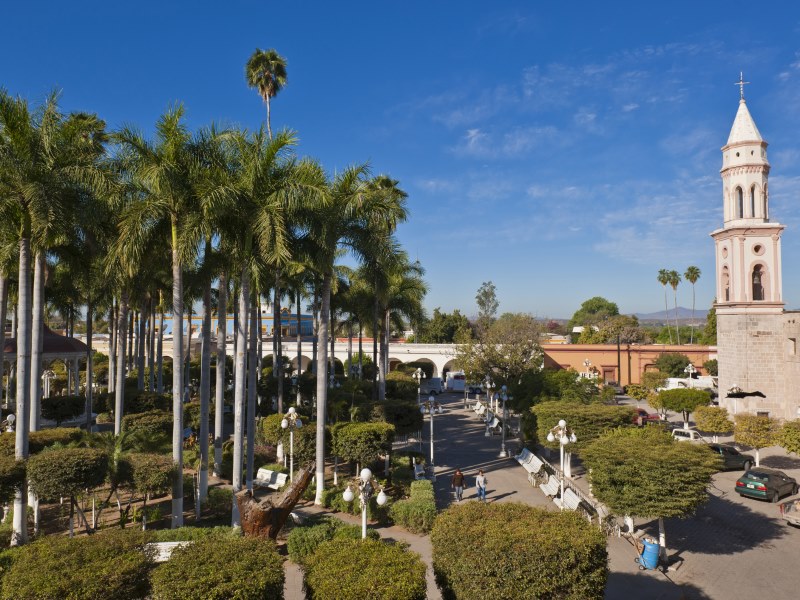
By Vanessa Nielsen
Travel Writer5 Feb 2019 - 6 Minute Read
I look out the window and feel a deep swoosh in my stomach, noting the abrupt drop into the green, tree-covered canyon.
I’m aboard El Chepe, aka the Chihuahua-Pacific Railway, a major rail line in Northwest Mexico. This beautiful passenger train connects the states of Chihuahua and Sinaloa along a 405mi (652km) span, crossing 86 tunnels, 37 bridges, and rugged Copper Canyon. Our conductor tells us that some call this the most scenic railroad trip on the continent. .
My parents, siblings and I have just left Creel, home of Rarámuri marathon runners (members of Chihuahua’s native indigenous tribe, who regularly win ultramarathons around the world while running in basic sandals). It’s also the site of Valle de los Monjes (Valley of the Monks), otherwise known as the Valley of the Gods. Legend has it that the enormous rock formations there are the petrified remains of monks caught forever in deep meditation. So, this would be an ideal setting to think really deep thoughts, but all I can think about is the Italian couple we met in Creel.

Clad in brightly patterned, slightly faded cotton pants, their clothes and beautiful tanned faces made them hard to miss. It turns out they were on their honeymoon, backpacking through Mexico (the cotton pants dried fast and hid stains, they explained). I had fallen madly in love with their warmth, their beauty, and their worldliness. Now, on the train, I realize that I am also slightly jealous of them. But why?
Four months ago, I had left Mexico in a terrible mood, bound for the United States and college thanks to a scholarship that was making it all possible. I was grateful for the opportunity (or, at least, I was trying to be). I was also terrified by the knowledge that I probably wouldn’t live in Mexico again for a long time, if ever.
I’ve spent the past few months insisting that, yes, despite my light skin, greenish eyes, and easy English, I really am from Mexico; no, not New Mexico; yes, I speak Spanish. I feel defensive of my Mexicanness, protective of an identity that is hidden by my outward appearance. It feels as fragile as a bean sprout, easily squashed by a world where it’s easier if my answers require less explanation.

On the train, I warm my hands around a mug of chocolate Abuelita, Mexican hot chocolate. It’s my 15th cup this trip; I’m drinking it the way most people drink coffee, warmed by a lifetime of memories of little chocolate tablets melting into a pot of frothy milk.
This will become a huge part of all of my visits home, I realize, a scavenger hunt of the foods and drinks and candy present in my most memorable childhood moments.
As I slowly sip, I concentrate on the beautiful Italians until I figure out the puzzle of my envy: I long for their unambiguous Italianness. I want to travel the way they travel, move through a foreign country but know that everyone realizes where I’m from, who I am. I want to rest assured that my place is waiting for me in Mexico. I’m desperate to know that I’ll come back to the sun that shone on my childhood after a few adventures in the snow and the pines.
El Chepe finally rolls into El Fuerte, Sinaloa — a pueblo mágico (magic town) known for its colonial architecture and indigenous dance tradition, and the end of our train journey. It’s New Year’s Eve.

We find out from our waiter at dinner that there’s a dance tonight near the town plaza, so we go. People stand in a circle around the open dance floor: men in cowboy hats, women with shiny long hair tumbling down their backs. Not many people have gathered the courage to dance yet, but that will change soon enough. It feels delightfully familiar, this dance in a small town 620mi (1,000km) south of my small hometown in Chihuahua.
“Hello, güerita,” I hear from behind me. This too, is familiar: my fellow Mexicans calling me “blondie,” and dusting off their best English for my benefit. “La güerita viene acompañada,” (the blondie is not alone), my dad growls, and the man draws back with a sheepish grin.
An hour or so later, the dance has gotten more raucous. Someone spills a beer nearby, there’s a flying fist, and my parents push us all out the door (“Before someone meets the end of MY fist,” my dad says).
A few days later, I will go back to the United States, perhaps a little more Mexican. And several months after that, I will return, perhaps a little less so. With every border crossing, I will try to make myself porous, to absorb all of the sights and smells and tastes of my beautiful Mexico. I’ll store them inside and ration them out, one by one, when the homesickness roars.
And eventually, I’ll realize that my Mexicanness has been fed by pueblos mágicos and beautiful food and Spanish, the language of love. It is not a bean sprout. It’s as deep as Copper Canyon, as strong as the petrified monk rocks, and as big as the state of Chihuahua.
Discover similar stories in
connection
Travel Writer
Vanessa is the founder and CEO of Sol Book Box, the Spanish children’s book subscription for families and bilingual bookworms. Born and raised in Mexico, Vanessa has lived and worked in the United States, France, and Honduras.



No Comments